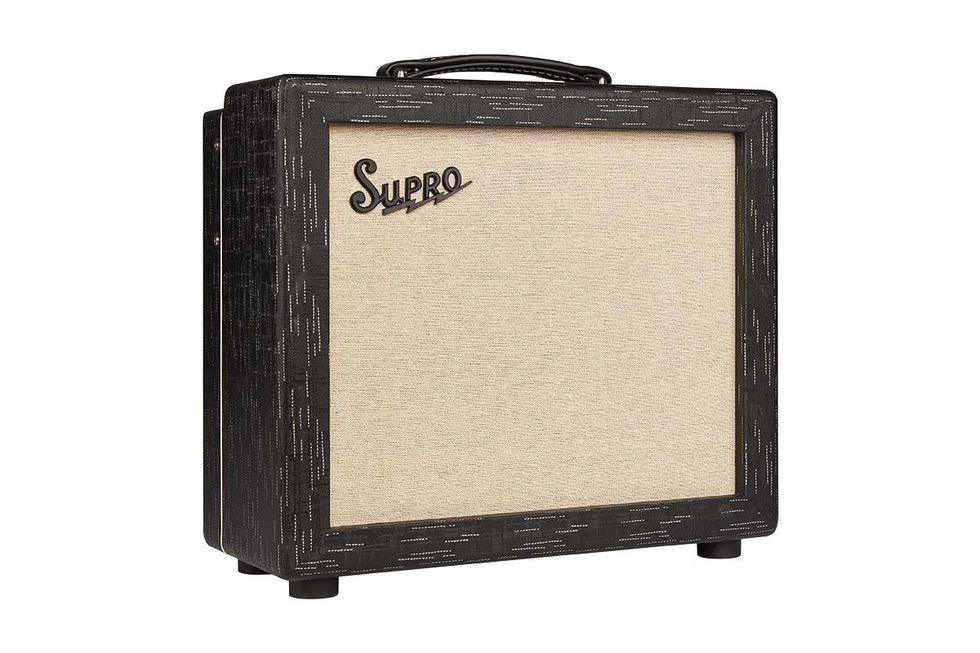If current trends are any indication, lower stage and studio volumes are with us to stay, and Supro, in particular, has built a lot of low-power amps to serve this segment of the market. The Amulet is the latest in a line built to satisfy small-amp appetites and deal thick, vintage-leaning tone.
The Amulet’s 15-watt, 1x10 combo configuration delivers a lot of flexibility: a simple control panel, nice tremolo and reverb sections, and a useful attenuator, which offers power scaling ranging from 15, 5, or a single watt. The output stage, meanwhile, is Class A and driven by a 6L6GC tube, rather than pairs of smaller 6V6s or EL84s, which drive the most common 15-watt tube amps. Together, these design features make Amulet an interesting and unique Princeton Reverb alternative.
Young, Free, and Single
The Amulet’s control panel will make any 1960s combo amp fan feel right at home. Volume, treble, bass, reverb, and tremolo speed and depth make up the control compliment, save for the 3-position output power switch. The Amulet is a looker, too, like just about everything we’ve seen from the revitalized Supro. Housed in a compact 17.5" x 17" x 8" poplar cabinet and weighing just 29 pounds, it’s covered in stylish black Scandia vinyl with cream piping and a cream grille cloth. A large leatherette handle makes for a super-comfy carry. The speaker is a Celestion G10 Creamback rated at 45 watts.
Given the Class A output stage, you could view the Amulet almost as a beefed-up Champ with extras. The past couple of decades have seen a variety of creative Class A offerings, like the THD UniValve, Victoria Regal (and double-single-ended Regal II), Emery Sound Microbaby, Blackheart Little Giant, the original Carr Mercury, and others. But only the Carr came with a built-in attenuator like the Amulet’s, so it’s nice and rare to see power scaling in this circuit type, at this power level, and at this price. Amulet’s true class-A output and the associated second-order harmonics add to the brew, which most will hear as lively, deep, overtone-rich, and more multi-dimensional in overdriven settings.
The whole of the Amulet’s circuit is tube-driven. There are 12AX7 preamp tubes for the preamp gain stage, reverb gain make-up, and tremolo sections, and a single 12AT7 driving the front end of the spring reverb. Inside, a rugged-looking printed circuit board is populated with quality, through-hole components and board-mounted tube sockets.
Good Luck Charm
The Supro Amulet is a pretty handy box of tricks, given the small package. At lower settings on the volume knob and ranging up to about 11 o’clock, it sounds clean, crisp, and detailed, with body and balance. And despite the modest 15 watts, it feels powerful enough that you could maintain those clean tones in a small club with a volume-conscious rhythm section. Add lush reverb and rich, warm tremolo to taste, and there are some superb atmospheric cleans to be found—offering great sonics for retro swamp-rock, surf, alt-country, and indie textures.
The Amulet offers nice shades of breakup between 1 o’clock and 3 o’clock, but roars when it’s cranked. Assuming that you’ll want to use this capability often, the 15-watt setting will likely be too loud for many home studios. But you can still hit this sweet spot at 5 watts. And apartment dwellers and bedroom jammers that need to use the 1-watt position will still find lots of nice tones. At its sweetest, though, Amulet generates chewy, thick, rowdy, vintage-flavored overdrive and loads of compression without totally sacrificing dynamics.
While the amp’s natural overdrive is expressive in the right setting, it’s awesome with overdrive pedals, too—particularly with amp volumes around 10 to 11 o’clock. One of my favorite pedal/amp recipes was a grinding, plexi-like Friedman overdrive with the Supro set to 15 watts and a clean-but-almost-dirty volume. With a Telecaster out front, the Amulet had the sting of Jimmy Page’s early Led Zeppelin solos. Class A amps are rarely blessed with much low-end thump. Faster onset of compression and sag is usually part of the brew, too. The Amulet is no different in either regard, but it has a way of reminding you how these characteristics can be real virtues and makes the Amulet an exciting amp live or in the studio.
The Verdict
The Supro Amulet is a super-likeable and super-useful amp. The retro styling is a winner. Tones range from crispy to juicy at a range of output levels thanks to the built-in attenuator. The reverb and tremolo are both very good, and it pairs beautifully with overdrive pedals. If, to your ears, that adds up to fun and musical versatility, you’d be wise to give the Amulet a listen.




















